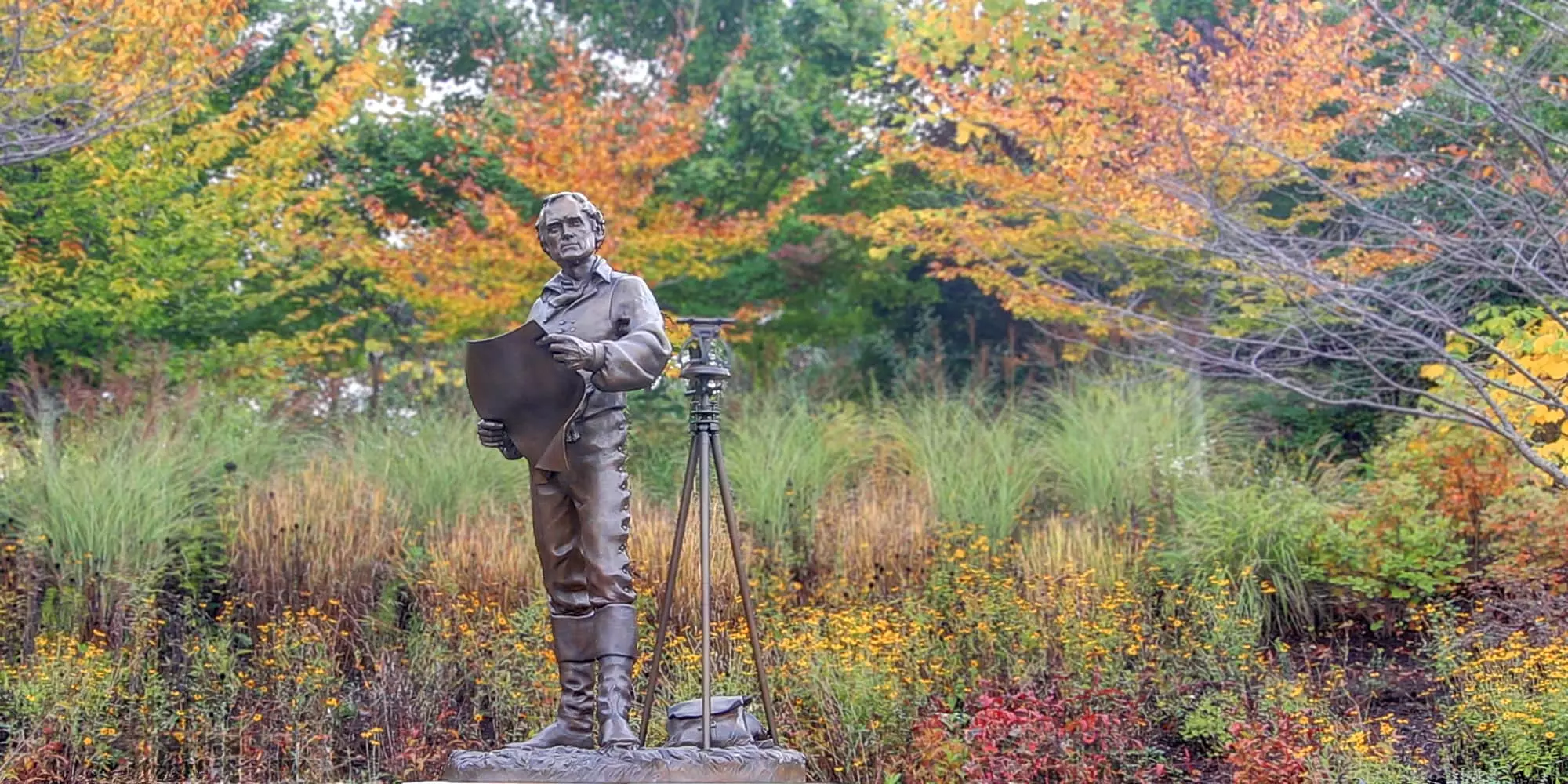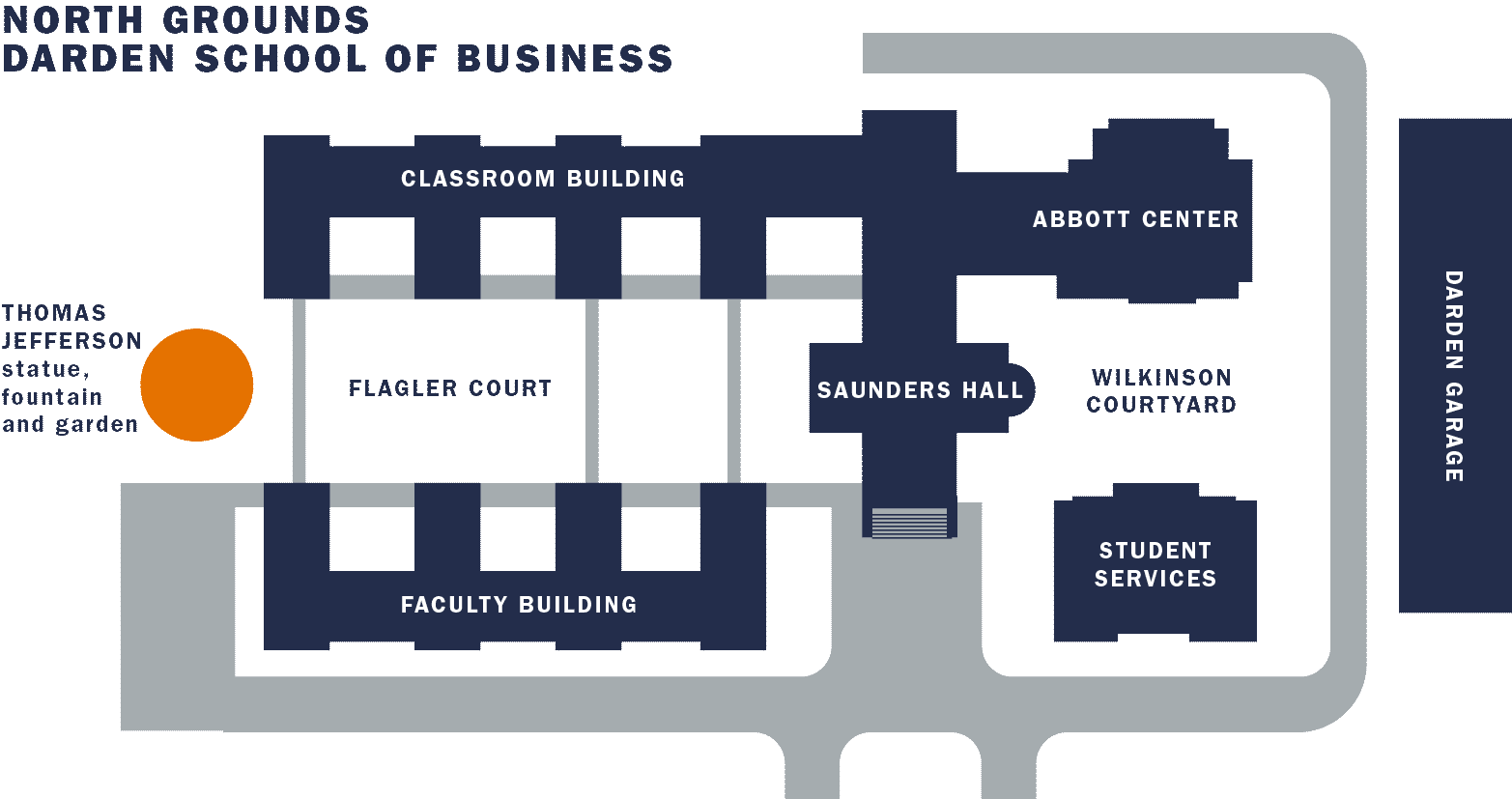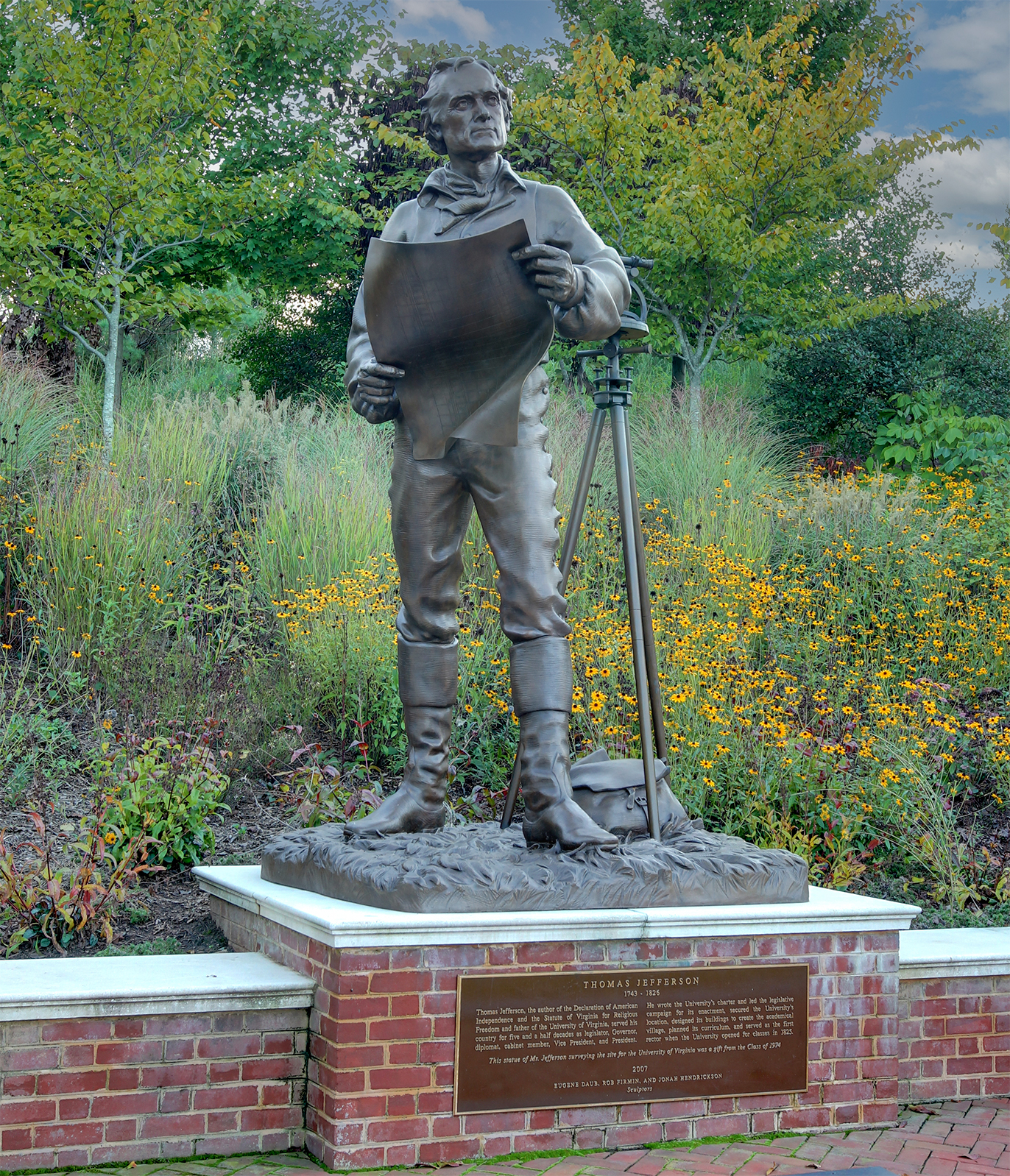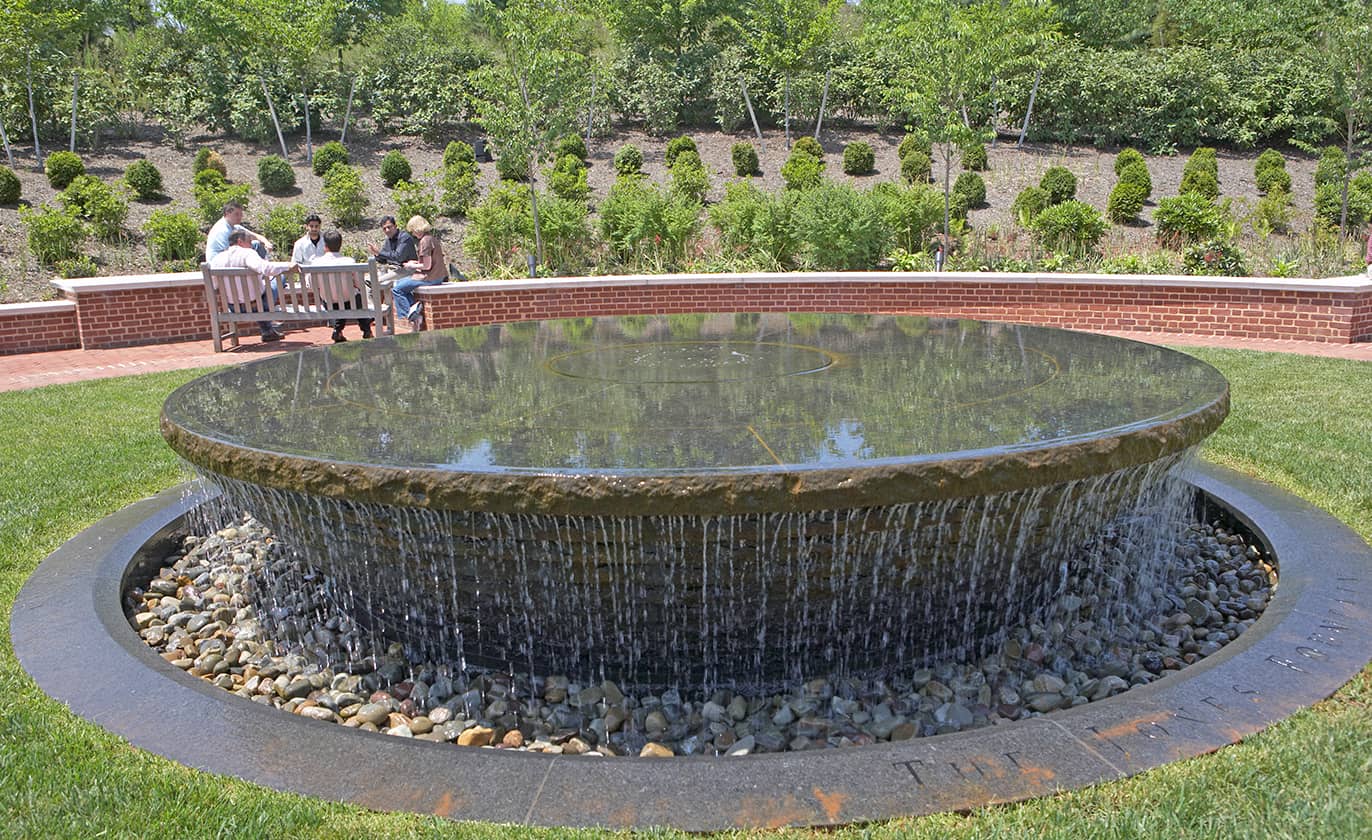
The Class of 1974 Garden and Thomas Jefferson Sculpture

"I like the dreams of the future better than the history of the past."
– Thomas Jefferson, Monticello 1816
On the 18th day of July 1817, Mr. Jefferson rode his horse, Bremo, from Monticello to survey the grounds of his academic village. He began his work by setting up his theodolite and surveying the hilly site. Using stakes cut from black locust shingles, he staked out the beginnings of “The Lawn.” Reconsidering his 1814 plans, he determined there needed to be a principal building in the center of the north end of The Lawn.
He would later write that day that this was the first time he considered such a building.
Mr. Jefferson is thinking…his eyes are focusing on the design of that important building. He would ultimately create the Rotunda.
This sculpture captures that moment of personal triumph when Mr. Jefferson takes the first physical steps to realize his long-standing dream of founding a great university. It celebrates a man who was still dreaming, still creating, and still working at the age of 74. This man is Thomas Jefferson, as he described himself on his tombstone, “The Father of The University of Virginia.”

Jefferson’s Facial Features
The sculpture depicts Jefferson at age 74 rather than the far younger ages at which he is normally represented. His facial appearance is taken from the complete set of life portraits compiled by Bush (1987), the bust by Jean-Antoine Houdon and the life cast by Browere. Jefferson has been described as a man who at the age of 80 appeared to be 60. He was physically active as a horseman up through and past the period reflected in this sculpture.
Thomas Jefferson’s Clothing
Jefferson’s Sherryvallies, or riding chaps, from which this reproduction pair was made, date from 1800–1825. Sherryvallies were put on over a man’s breeches to protect them from dust and dirt when riding. When arriving at a destination, they could easily be removed. Sherryvallies were made of reddish-brown twilled cotton with linen facings on the inside, cut like a pair of knee breeches, with no fly opening and a single row of brass buttons with corresponding buttonholes up the outside of each leg all the way to the waistband. Jefferson’s overseer, Edmund Bacon (1785–1866) remembered that when Jefferson "rode on horseback he had a pair of overalls that he always put on." – Quote courtesy of Carrie Taylor, Jefferson Foundation.
His shirt would have been made of cotton and cut blousy, as was practically every shirt of the period. By 1817, Jefferson would likely not have wrapped a colonial-era stock around his neck and possibly would have knotted a scarf or cravat instead, as depicted on the sculpture.
Jefferson would have worn a waistcoat over his shirt (but not the well-known heavy, red waistcoat at Monticello). It would have been lightweight and sleeveless.
Jefferson possessed at least two pairs of riding boots of quite disparate design. The pair for the model of the Darden figure is in the Jefferson Foundation’s collection at Monticello. The design on the front of each boot is a pattern cut from an extension of the leather from the lower part of the boot, which overlaps the tubular leather of the leg of the boot. It was Jefferson’s habit to stick his riding crop into his right boot after dismounting, as depicted. The riding-crop design accurately reflects Jefferson’s, with leather stitched over the head.
Architectural Drawings
Mr. Jefferson is holding his two-sided architectural plans, drawn by his own hand three years earlier and approved by the Board of Visitors. (Updated drawings came later in 1817.) The side of the drawing facing you is of the first pavilion to be built, number VII, now The Colonnade Club. The side facing Jefferson shows his original concept for the Academical Village. Note that the North end does not include The Rotunda.
Items in Pockets
Jefferson was known to carry a number of useful implements in his pockets. The sculpture shows four: his architect’s rule, a pocket watch, sunglasses, and an ivory scratchpad. Jefferson often carried his architect’s rule in a pocket and would likely have done so whenever he had an architectural plan with him. Just as with modern architect’s rules, his has multiple scales engraved. Jefferson’s pocket watch is in the lower left pocket of his waistcoat and he had a pair of darkened glasses, which he called his “goggles.”
The ivory scratch pad served some of the functions of a contemporary PDA (Personal Digital Assistant). It consists of several ivory slats pinned together at one end like a fan. Jefferson wrote temporary notes on it with a grease pencil, transcribed them to his journal, and rubbed the slats clean. He apparently did this on the morning of July 18.
Theodolite
Jefferson used the theodolite sold by Jesse Ramsden of London for his July 18, 1817 survey. It was a sophisticated instrument for its date of construction and remained relatively so for many decades. It had a compass, two viewing tubes for sighting two reference points simultaneously, and calibration for the elevation of the tubes. It was calibrated in fractions of degrees around the sloped edge of the compass body. The theodolite in the sculpture is based on a direct inspection of the actual theodolite at Monticello. Two details on the theodolite reflect the compass needle pointing in the estimated correct direction, with magnetic declination adjusted for shifts in the magnetic north pole since 1817; and two inscriptions placed on the upward-facing surface of the compass by Jesse Ramsden in London.
Saddlebags
None of Jefferson’s saddlebags are known to have survived. The model for the pair of the Darden Jefferson sculpture belonged to Asaph Leavitt Bissell, a graduate of Yale Medical School’s second class dating from 1815. They are kept at the Yale Medical History Library.
“He did it, so can we, so can our children, our grandchildren and our great-grandchildren. This sculpture is about you. It is never too late. Take a good look here. Be inspired.”
– Rob Firmin, at the dedication on September 22, 2007
“No occupation is so delightful to me as the culture of the earth and no culture comparable to that of the garden.”
–Thomas Jefferson, 1811
During their 30th reunion, the Class decided on a gift that would be a lasting reminder of their presence at Darden. The Class especially wanted a gift that both Darden and the University of Virginia would enjoy. Thus, the Thomas Jefferson Sculpture and Garden were conceived and brought to life.

An advisory committee comprised of members of the Class of 1974, scholars from the University of Virginia, and experts from Monticello’s Thomas Jefferson Foundation chose the firm of Daub Firmin Hendrickson of Berkeley, California, to design and create the Darden Jefferson Sculpture. Siteworks of Charlottesville, Virginia, and Monticello’s historian researched and designed the surrounding garden. The garden hillside contains plants, trees and flowers found at Thomas Jefferson’s Monticello and in Albemarle County. The plantings provide a seasonal array of beauty throughout the year.
“Green spaces and gardens were part of Mr. Jefferson’s original plan for his university. We take seriously our responsibility to maintain this balance across the Grounds.”
– University of Virginia President John Casteen,
at the dedication on September 22, 2007
“The graceful and perpetual spray of water…”
—Thomas Jefferson, Monticello
On a return trip from France, Jefferson remarked, “I was exposed to the wonders of European architecture and the French neo-classical designs, and upon my return, I introduced many of these elements to Monticello to resemble a French neo-classical townhouse. The concept of a fountain is quite intriguing as running water soothes the soul…” There is no evidence that Jefferson ever got his fountain at Monticello.

To make one of Jefferson’s wishes and longings a reality, Gary T. Jones (MBA ’74) and his wife, Libby, wanted to complement the Class of 1974 Garden and Thomas Jefferson statue by adding a fountain to this setting.
The circular fountain is constructed of Masabi Black granite with a highly polished finish for the top and a highly rusticated finish on the sides. The fountain includes two thermal-finished granite paving bands. The inner band marks the edge of the basin for re-circulating the water and is inscribed with the names of the donors. The outer band encircles the lawn at the edge of the brick walk and provides the location of Thomas Jefferson’s quote to John Adams on August 1, 1816, “I like the dreams of the future better than the history of the past.”